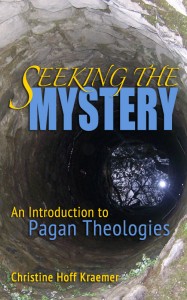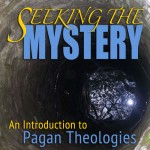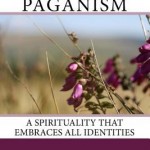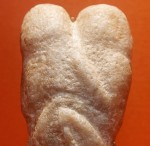On Monday 7/1 and through the end of the business day on Tuesday 7/2, Amazon.com will be offering the Kindle edition of Seeking the Mystery: An Introduction to Pagan Theologies for $0.99. It will be available at a reduced price of $2.99 for about a week thereafter. It’s now out in paperback too!
For those who have Pagan reading groups, I especially hope you’ll consider it as one of your selections. Each chapter ends with a summary, discussion questions, and activities — great for groups and individuals alike.
[BUY NOW]
Want a preview? You can read the table of contents, introduction, and glossary here, reviews here, and an excerpt from Chapter One below.
Excerpt from Chapter One: Deity, Deities, and the Divine
Hard Polytheism
Hard polytheism is the view that the gods are objectively existing, independent personalities with whom human beings can have relationships. This theological position is somewhat unique in contemporary Paganism because it is the only belief around which groups of Pagans have strongly rallied. Interestingly, although conversations around hard polytheism are often framed in terms of belief, hard polytheists’ objections to soft polytheism are primarily about the way belief informs practice. For hard polytheists, soft polytheist practice—especially practice that approaches the gods as interchangeable archetypes—is both less effective and potentially disrespectful. Pagans will sometimes speak of rituals where the gods do not “show up”—no energy moves, no sense of connection or presence is felt, and the participants return home in much the same mental and emotional state in which they arrived. Hard polytheists believe that this undesirable state of affairs occurs because Pagans do not recognize the nature of the gods. Hard polytheists usually experience the gods as powerful presences with distinctive desires and behaviors, as well as historical ties to particular traditions, cultures, and lands. In order to connect with a goddess or a god and form relationship with them, hard polytheists will look at rituals from the deity’s native culture for guidance. When they ask a goddess or god to be present, they see themselves as calling someone very specific. Some use the metaphor of dialing a phone number to reach a friend: the ritual objects and the proper names and prayers are ways of ensuring one has the right number. Once a deity has been contacted, an ongoing relationship can be formed through prayer and ritual. This experiential relationship allows the practitioner to move beyond attempting to reconstruct an ancient religion using historical texts, and instead to create a practice that is oriented to the present.
Hard polytheists often see soft polytheists as “dialing a wrong number.” Soft polytheists may treat named deities such as Aphrodite and Ishtar as if they were interchangeable—both forms of an archetypal “love goddess.” To hard polytheists, this is disrespectful to the deities involved, a bit like treating two cousins as if they were the same person. A practice that does not take the deities seriously as individuals is thought to produce either weak results or none at all—or, in certain unhappy cases, a true “wrong number” where a mischievous spirit pretends to be the desired deity. Hard polytheists are also critical of soft polytheist practices that they see as self-indulgent or self-serving. Although hard polytheists do not necessarily see their deities as infallible, they regard them as sources of wisdom and inspiration who deserve devotion and service. They are concerned with the possibility that eclectic Pagans will pick and choose what appeals to them from ancient traditions while thoughtlessly rejecting anything that seems uncomfortable, or that they will make up their own traditions without being well-educated in existing ones. In their view, a soft polytheist practice may be too undisciplined to result in genuine connection with divine forces.
Hard polytheist practice contrasts strongly with the monotheism that is dominant in Western culture. As a result, hard polytheists can be actively hostile to monistic language in Paganism. Part of this may be due to a misunderstanding of monism. Hard polytheists are strongly opposed to the idea that “All gods are one God,” and they tend to equate this view with monism. Yet monism does not necessarily imply a belief in a unifying personal God. Rather, it can simply indicate a belief in a unifying divine substance. Some hard polytheists do espouse ideas that are compatible with monism. Raven Kaldera is an outspoken advocate for hard polytheism in contemporary Paganism. In Dealing with Deities, he addresses the cross-cultural similarities between groups of gods and goddesses that some thinkers have identified as archetypes. Many polytheistic cultures, for example, have a “love goddess” of some kind. Kaldera speaks of these individual deities as sharing a divine energy current that unites them and gives them a family resemblance, while still remaining distinct personalities.[i] To draw an analogy on the human level, although a friend may be a member of a family or a citizen of a town, I don’t generally think of her as “one of the Joneses” or “a Bostonian”—I think of her as “Katherine” and as an individual. Ivo Dominguez, Jr. expresses a similar idea in his book Spirit Speak, where he describes different levels of deity forms. For Dominguez, the named gods are also part of larger and more diffuse deity forms that unite them. Importantly, however, neither Kaldera nor Dominguez see these uniting energies as the primary focus of Pagan practice. Both take the reality of individual Pagan deities as seriously as they take the reality of individual human beings. Deities may partake in larger energies, but these writers believe that Pagans can relate to them as distinct.
For some hard polytheists, the distinction between hard and soft polytheism is primarily a difference in emphasis. In the creation myth told by Starhawk, for example, the Star Goddess gives birth to all the beings of the universe, of whom she is also part. A soft polytheist is likely to focus on the Star Goddess in this story as the common origin of all things. She may seem to be the most important deity, the oneness (or the nothingness) of which all the others are part. Yet it is not just the gods that remain a part of her, but also human beings, plants, and animals. A hard polytheist is more likely to see such a Goddess as somewhat distant and abstract, while her children—both gods and mortals—are closer to us and available for relationship. In general, hard polytheists who admit to monist underpinnings are likely to see their monism as irrelevant to their practice. The idea that there is an underlying spiritual substance to being may be an interesting metaphysical idea, but it has little impact on the everyday. (Alternatively, hard polytheists may see “divinity” as a quality shared by all deities, but deny that there is a unifying substance to being. Just as an apple and a stop sign are both “red,” but not of the same substance, Aphrodite and Parvati might both be “love goddesses” and both “divine,” but not of the same substance. This is a non-monist position that nevertheless affirms an essential commonality among the gods.)
Hard polytheists tend to take the issue of belief much more seriously than other Pagans. Like other Pagans, they usually emphasize that their belief in the gods is based on their personal experiences of them. However, hard polytheists see belief as a necessary part of the passion and devotion that is part of a committed relationship with the gods. As Hellenic polytheist Sarah Kate Istra Winter writes,
I fear that paganism may not have the strength to last in the long-term if we ourselves do not firmly believe in our spiritual reality. You don’t see Christians following up a discussion of accepting Jesus into your heart with some caveat like “or if you don’t believe in Jesus, just imagine a similar loving entity or warm light.” Or “if you need the help of a saint and don’t like any of the ones you’ve read about, just invent a new saint in your mind that betters suits you, and contact them.” As if these things are all the same. Yes, I know that many Christians go in the opposite direction and become strictly orthodox, insisting on every detail of belief, and I also know that this is what many pagans are reacting to. But it’s time to stop reacting and start building a real, solid faith that will last – and for that you need, well, faith.[ii]
Although in this passage Winter emphasizes the necessity of belief for the Pagan movement as a whole, hard polytheist thinkers also acknowledge belief’s personal dimension. Even the most devoted Pagan will not always experience the gods in all their glory; not every ritual will produce awe, ecstasy, or divine terror. In those cases, belief can help to sustain a spiritually nurturing practice. As Heathen practitioner Galina Krasskova remarked to me, “Faith and practice support me when I can’t feel the gods.”
Perhaps because hard polytheists are more likely to acknowledge the necessity of believing in and understanding the nature of the gods, much of the innovative contemporary Pagan theology of the past two decades has come from a hard polytheist perspective. Druid John Michael Greer’s A World Full of Gods explores polytheism as an ethical as well as a metaphysical position. Greer spends much of his time attacking pre-twentieth century Christian theology, which may be frustrating for those who are aware that progressive Christian theology has already made these criticisms. But Greer does make a strong case for polytheism as an inherently pluralistic system in which religious tolerance and the celebration of diversity make sense. Since it is obvious from history that individuals and cultures experience the divine very differently, polytheism provides a system of thought that does not have to explain those differences away.
Other hard polytheists have focused on theoretical frameworks to support their devotional approaches, such as Northern tradition Pagan Raven Kaldera’s Dealing with Deities: Practical Polytheistic Theology. For Kaldera, theology is not abstract or based on speculation; “faith” is a matter of trust and ongoing relationship with the gods, based on the assurance of things experienced and the conviction of things seen. He also touches on archetypal and syncretistic experiences, which have often been considered evidence for soft polytheism. Contemporary Pagans sometimes interpret similarities between deities as evidence that they have encountered a universal archetype, rather than two separate beings. These archetypal experiences seem supported by historical cases of syncretism, where deities originally from different cultures have been worshipped as the same deity. To provide a more sophisticated hard polytheist explanation for these experiences, theologian P. Sufenas Virius Lupus uses process theology and the work of polytheistic philosopher Edward P. Butler.[iii] Lupus argues that deities change and evolve along with human beings, which allows new relationships to be formed among the gods over time. In turn, changes in the gods lead to changes in their relationships with humans. Lupus aims to help polytheist Pagans form deeper relationships with the gods by coming to a more consistent understanding of them.
[i] Raven Kaldera, Dealing with Deities: Practical Polytheistic Theology (Hubbardston, MA: Asphodel Press, 2012), 43.
[ii] Sarah Kate Istra Winter, Dwelling on the Threshold (CreateSpace, 2012), 21. Also available at A Forest Door, https://forestdoor.wordpress.com/2010/06/09/the-gods-are-real/.
[iii] See P. Sufenas Virius Lupus, “Polytheology: Syncretism, Process Theology, and ‘Polyamorotheism,’” Patheos.com 2 Aug 2010, available at http://www.patheos.com/Resources/Additional-Resources/Polytheology-Syncretism-Process-Theology-and-Polyamorotheism; and “PantheaCon 2012: Super-Syncretism! Creating Connection & Preserving Diversity,” Aedicula Antinoi: A Small Shrine of Antinous 31 Mar 2012, available at http://aediculaantinoi.wordpress.com/2012/03/31/pantheacon-2012-super-syncretism-creating-connection-preserving-diversity/. Expanded versions of these ideas are available in A Serpent Path Primer (Red Lotus Library, 2012).
















